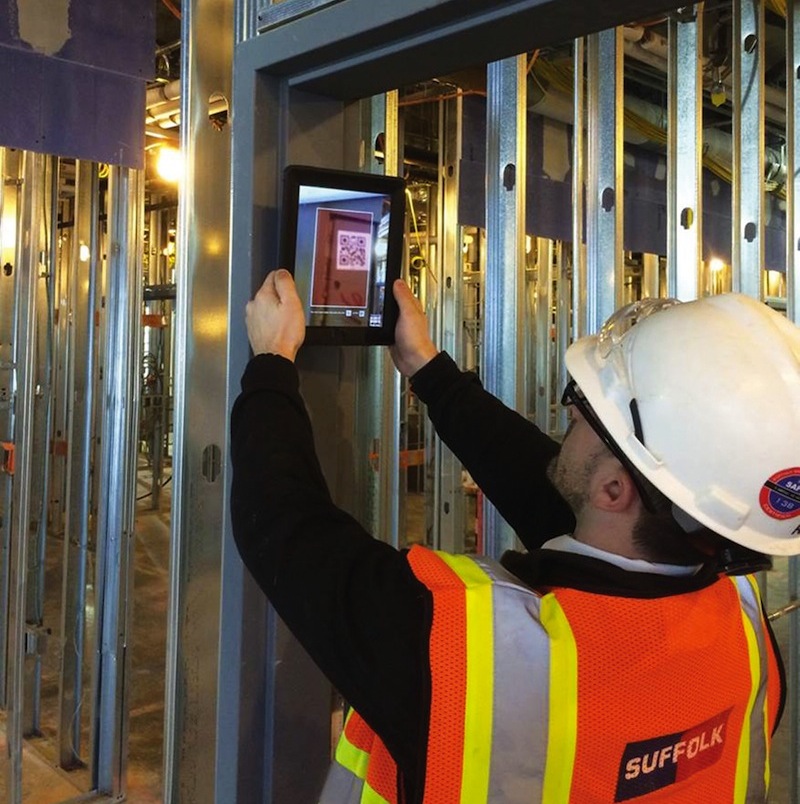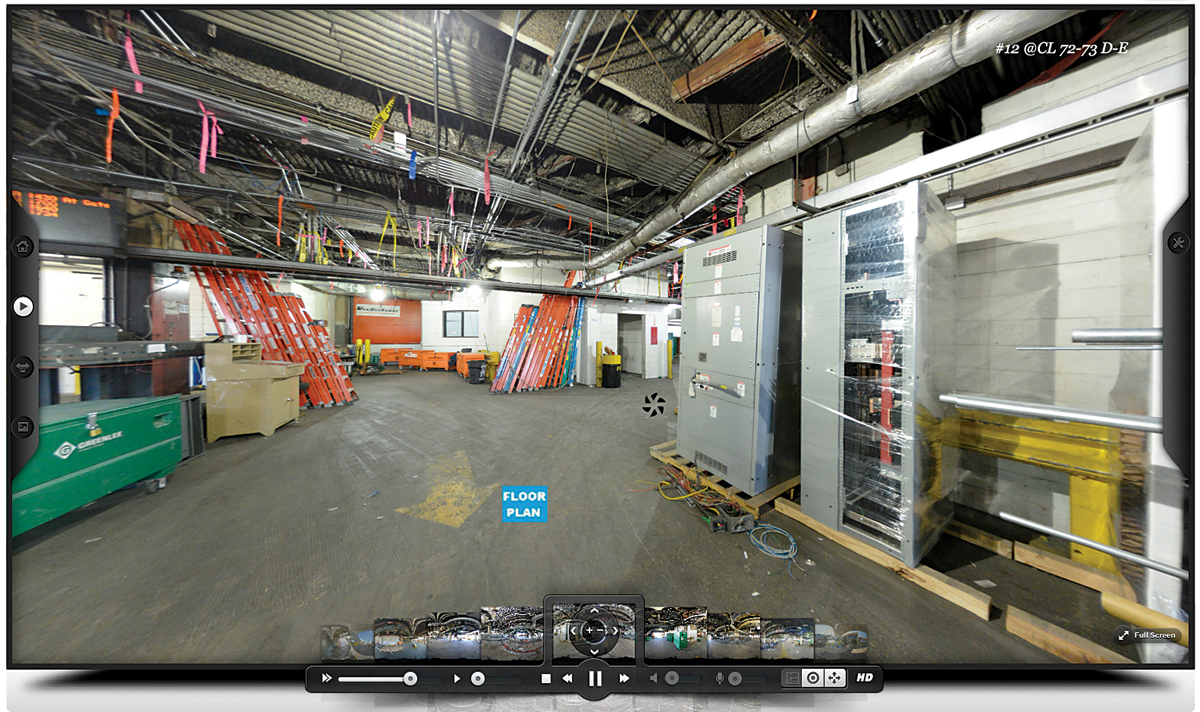Drones, GoPro, RFID, Oculus Rift, augmented reality, 360 cameras, 3D laser scanners, GIS systems. There’s no shortage of tech gadgets that are ripe for adoption on commercial construction projects. Making these tech tools even more enticing for construction firms are the low barrier to entry—for example, professional-grade drones go for as low as $650—and improved integration with existing workflows and systems.
“It’s been overwhelming at times just trying to get a handle on all the new innovations,” says James Barrett, VP and Chief Innovation Officer with Turner Construction. “It’s easy to get caught up in the coolness of these tools, but I feel like some of them are just a solution looking for a problem.” Turner takes an incremental approach to technology adoption, selecting the tools that offer the most favorable cost-to-benefit ratio.
In late 2013, Suffolk Construction formed a 12-person R&D team to help keep up with emerging technologies. The group, led by Senior Project Manager Jason Seaburg, has a formal process for testing new gadgets, including twice-monthly conference calls and timelines for testing.
“We work in an industry that, quite honestly, is a decade behind the times when it comes to technology,” says Seaburg. “We need to foster a culture and mindset where it’s OK to beta test all these new technologies hitting the market, and where it’s OK to fail. If a particular tool doesn’t work, that’s fine, we’ll move on to the next thing.”
To find out which technologies are working for contractors, and which emerging applications show promise, BD+C reached out to several giant contractor firms. Here’s what they had to offer:
1. 360 cameras simplify visual documentation.
Manhattan Construction has seen huge benefits from the use 360 cameras. Manhattan’s Mark Penny, an SVP in the firm’s Dallas office, says the technology has greatly reduced the need for client/team site visits on the multi-year DFW International Airport modernization and improvement project. It also has assisted the team with making sense of the existing conditions (very few as-built drawings exist) and documenting the construction progress.
Every two weeks, during routine field walks of the job site, the project’s superintendent uses a Nikon D7100, fitted with a fisheye lens for panoramic shots, to take four images from dozens of predetermined locations across the site. The images from each location are then stitched together using PTGui software (www.ptgui.com) and linked to a custom digital floor plan of the project via Real Tour Vision (www.realtourvision.com), allowing anyone on the team to take a virtual, high-definition tour of the facility.
“Say there’s a conflict with ductwork,” says Penny. “We can pull up the latest photo of that area, pan and zoom to that exact spot, and collaborate with the designers and client—virtually—to resolve it.”
2. Teams are taking control of video.
Tech gadgets like drones, GoPros, and tablets make video capture a breeze in the field. The issue for contractors is what to do with the information—how best to archive video for future use, or tie it in with the construction information workflow.
Both Suffolk and Turner are working with software developers to create custom tools to help take control of their video data. Suffolk is planning a YouTube-like website that will allow its staff to upload and quickly retrieve project videos. The most novel feature: an advanced search function that will take viewers to a specific point of a video based on keyword input. “It could be a three-hour project video, but you need to see the foundation installation at the 12-minute mark,” says Seaburg. “This tool will take you to that exact spot.”
Turner is working with software engineers at the University of Illinois at Urbana–Champaign to develop an automated safety check program that will analyze video feeds to identify workers who are not wearing safety gear, such as hardhats, vests, and glasses. “Our push has been to leverage easily accessible technologies, like video and photos, combined with advanced analysis, to solve problems,” says Barrett.
3. Rise of the smart factory network.
No tech innovation is making a bigger impact on construction projects than prefabrication, says Barrett. Building Teams are experiencing sizable gains in schedule and workforce efficiencies, and are looking for new ways to move the “big thinking” off the job site and into a factory-like setting. Precast exterior walls, unitized curtain wall, multi-trade racks, bathrooms pods, prefab head walls, and equipment skids are now commonplace on major projects. Emerging applications include precast foundations and interior partitions.
“The smartest job site is not one site, but a network of job sites where trade contractors are prefabricating components in a clean, controlled environment, and then delivering them only as needed,” says Barrett.
Trade contractors are becoming increasingly sophisticated, says Barrett. He points to Quakertown, Pa.-based Klover Contracting, which recently launched a BIM-to-cold-roll-forming-machine workflow for the manufacture of light-gauge metal frame components for a variety of applications—interior partitions, roof and floor trusses, load-bearing wall panels, to name a few. Based on the rough BIM model for a given project, Klover’s team can create a detailed framing design that incorporates door/window openings, structural requirements, duct openings, and panel breaks. This file is then sent to the firm’s cold-roll forming machines, which “print” each component to precise specifications.
4. BIM in the field is starting to pay off.
 To speed the site inspection process at the 620,000-sf, 11-story Brigham Building for the Future project at Brigham and Women’s Hospital in Boston, Suffolk Construction implemented a QR-code-based BIM-in-the-field workflow. Team members can quickly call up documents for a given space and provide real-time feedback by scanning a QR code label affixed to the nearest doorframe. Courtesy Suffolk Construction
To speed the site inspection process at the 620,000-sf, 11-story Brigham Building for the Future project at Brigham and Women’s Hospital in Boston, Suffolk Construction implemented a QR-code-based BIM-in-the-field workflow. Team members can quickly call up documents for a given space and provide real-time feedback by scanning a QR code label affixed to the nearest doorframe. Courtesy Suffolk Construction
Suffolk is rolling out Autodesk’s BIM 360 Glue (cloud-based BIM/VDC coordination) and 360 Field (mobile project management) across the organization. One of the most useful applications, says Seaburg, is quality control inspection using the BIM 360 Field app on iPads, combined with QR codes on the job site.
On the firm’s $280 million, 620,000-sf Brigham Building for the Future project, currently under construction in Boston, the team placed QR codes on the door frames of every space in the complex. During work-list inspections (and eventually punch-list inspections), team members can open the 360 Field app and scan the QR code of a given room for a detailed, real-time list of work to be completed and questions to be addressed.
“From there, we can change the status, add comments, put it in dispute, mark it as complete, and even add a picture,” says Tom Reid, Suffolk’s Assistant Project Manager. “It allows us to work through lists almost in real time.”
5. RFID is on the cusp of going mainstream.
Turner has been studying RFID tracking for several years, and has implemented RFID solutions intermittently—with reasonable success, says Barrett.
“We’re chasing the low-hanging fruit, like tracking workers as they enter and leave the site, and to see if they’re up to date on their certifications,” he says. With newer solutions, like Trimble’s CrewSight system, Barrett believes RFID is ready for prime time.
“Costs have come down, and it’s becoming easier to deploy,” he says. “We’re looking to make it standard on projects.”
Related Stories
| Aug 11, 2010
ASHRAE releases free BIM introductory guide
A newly released guide from ASHRAE on building information models and building information modeling (BIM) serves as a resource for professionals considering BIM tools and applications for their businesses. According to "An Introduction to Building Information Modeling," BIM is “a digital representation of the physical and the functional characteristics of a facility.” Unlike 2D or 3D CAD, BIM software utilizes intelligent objects to create models.
| Aug 11, 2010
BIM research: New IPD document quantifies savings, shows obstacles
The American Institute of Architects and the AIA California Council have released the results of “Integrated Project Delivery: Case Studies,” a collection of six studies that showcases the process changes and efficiencies of completed building projects that utilized and implemented IPD. IPD is a construction project model in which owners, design professionals, and general contracto...
| Aug 11, 2010
Take the hassle out of managing subcontractors
As general contractors look to technology for an edge in the slowing commercial construction market, Web-based bidding programs are helping them to connecting bid information, subcontractors, and proposals. A 2008 survey by the Construction Financial Management Association found that 62% of general contractors participated in Web-based construction bidding vs.
| Aug 11, 2010
Wisconsin becomes the first state to require BIM on public projects
As of July 1, the Wisconsin Division of State Facilities will require all state projects with a total budget of $5 million or more and all new construction with a budget of $2.5 million or more to have their designs begin with a Building Information Model. The new guidelines and standards require A/E services in a design-bid-build project delivery format to use BIM and 3D software from initial ...
| Aug 11, 2010
News Briefs: GBCI begins testing for new LEED professional credentials... Architects rank durability over 'green' in product attributes... ABI falls slightly in April, but shows market improvement
News Briefs: GBCI begins testing for new LEED professional credentials... Architects rank durability over 'green' in product attributes... ABI falls slightly in April, but shows market improvement
| Aug 11, 2010
Luxury Hotel required faceted design
Goettsch Partners, Chicago, designed a new five-star, 214-room hotel for the King Abdullah Financial District (KAFD) in Riyadh, Saudi Arabia. The design-build project, with Saudi Oger Ltd. as contractor and Rayadah Investment Co. as developer, has a three-story podium supporting a 17-story glass tower with a nine-story opening that allows light to penetrate the mass of the building.
| Aug 11, 2010
Architectural Visualization Rendering the Future
Three-dimensional design tools have revolutionized the way architects and engineers design buildings; in recent years, parametric modeling has enabled Building Teams to impart weight tolerances and other intelligent information to a finished design. Yet many designers say they use 3D most in the conceptual design stage, when detailed building information is not necessary and can actually encumb...







